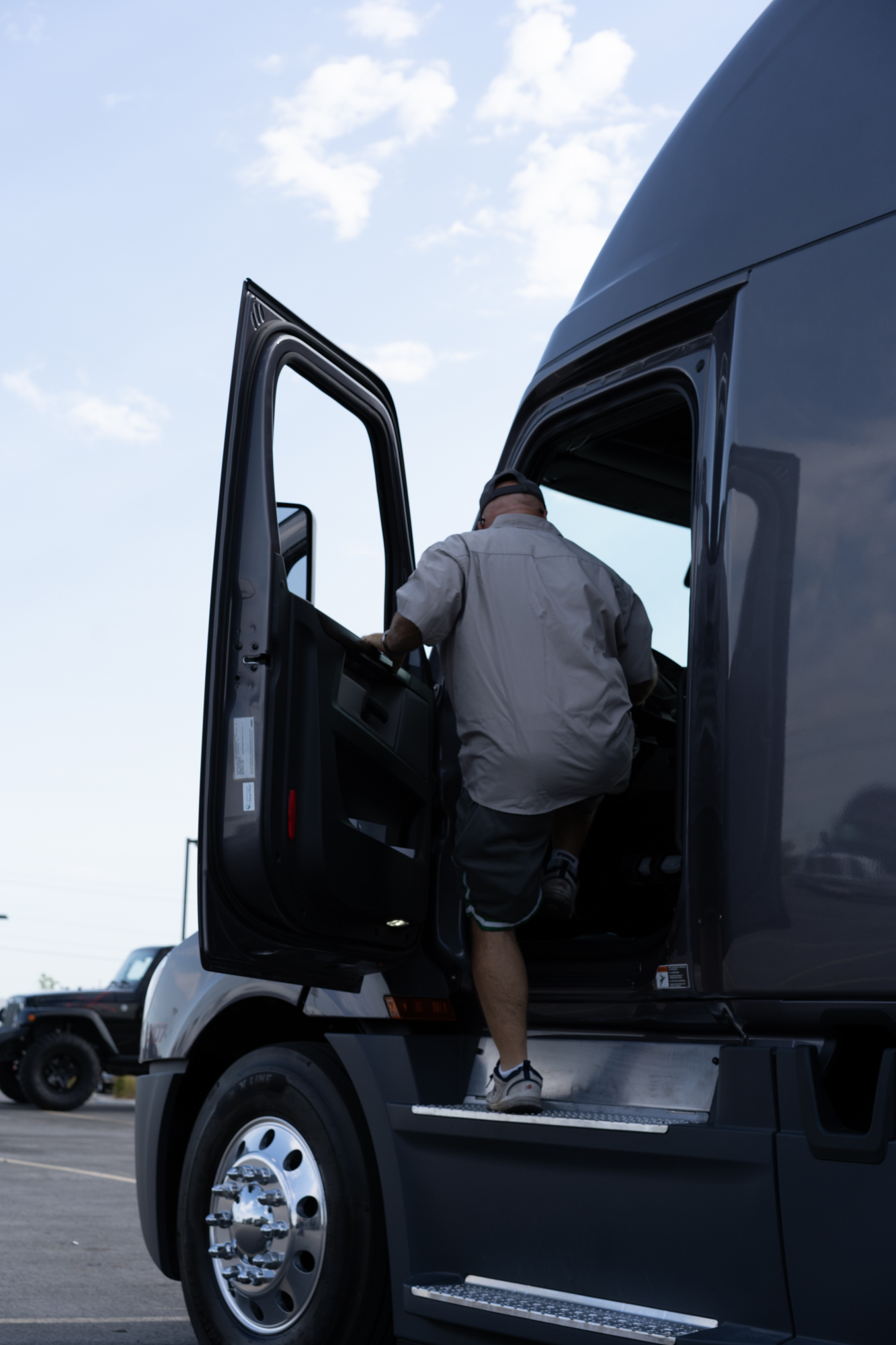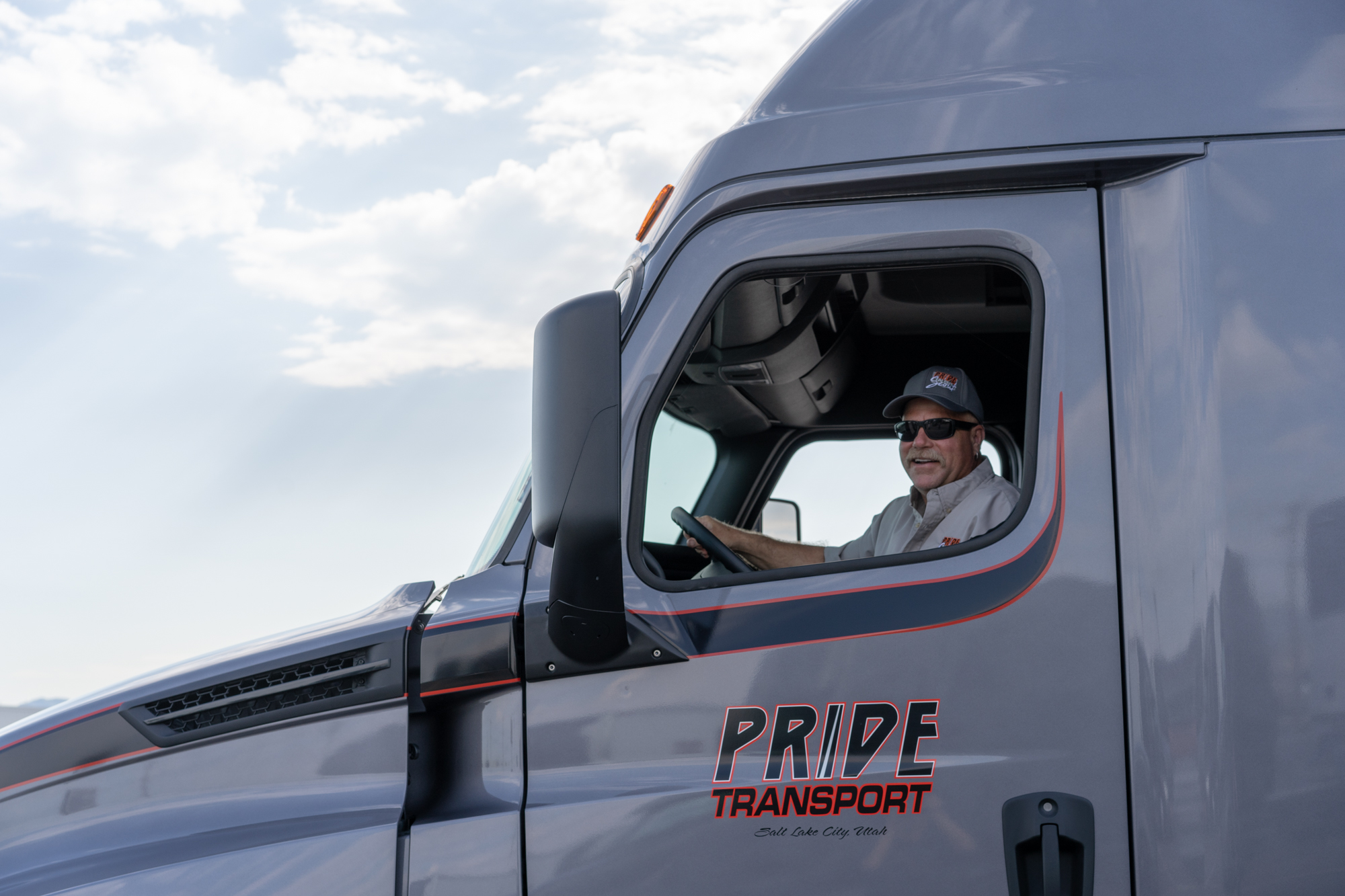by Pride Transport | Mar 27, 2025
Many people are used to working all day in an office, but for truck drivers, office life looks a little different. Truck drivers (OTR drivers in particular) spend their day in a workspace that is often traveling at 70 MPH while surrounded by other vehicles. And unlike many traditional office workers, truck drivers also have to contend with changing weather and road conditions — sometimes on really short notice! To do their job well, truck drivers rely on the safety features of semi-truck cabs.
Today’s cabs have come a long way since semi trucks first started transporting freight. Over the years, they’ve evolved to improve driver protection, enhance crash survivability, and even reduce driver fatigue. To learn more about truck cab safety and the latest protective features, keep reading.
How Safe Were the First Commercial Trucks?
Commercial trucks used for highway freight transport began hitting the roads in the 1930s. Peterbilt introduced its first commercial trucks for public sale in 1939. These vehicles featured an all-steel cab and were trimmed with plywood (a nod to the company’s origins creating logging trucks). At the time, an all-steel cab was likely about as safe as a CMV could get, but early trucks lacked many of the safety features that we would consider standard today.
Aerodynamics, fuel efficiency, and visibility were prioritized in early truck cab designs. While these all contribute to safety in their own way, they don’t offer substantial protection in the same way that seat belts, airbags, and rollover protection do. It would take a couple more decades before modern safety features became a normal part of semi-truck cab design.
Driving carefully (and hoping that others were doing the same!) was the best safety practice, but accidents still happened. Early cab designs increased the risk of driver injury due to their weak structures. Additionally, early truck cabs weren’t temperature controlled or soundproof, so exposure to extreme temperatures and rattling vibrations contributed to driver discomfort and fatigue.
Major Safety Advancements in Semi-Truck Cabs
The authorization of the U.S. Interstate Highway System in 1956 was the beginning of truly accessible cross-country travel. It’s no surprise that both passenger and commercial vehicles experienced a series of safety advancements from the 1950s through the 1970s.
For example, seat belts didn’t appear in passenger vehicles in the U.S. until the 1950s. And even then, they were usually sold as an optional feature — not as a mandatory part of the car’s design. (Airbags also took a while to make their way into American vehicles. Airbags were introduced in passenger vehicles in the 1970s but weren’t a mandatory vehicle feature until 1996!)
It wasn’t until 1968 that all cars sold in the U.S. were required to have seat belts, but in this case, commercial vehicles were ahead of the curve: seat belts meeting federal regulations were mandatory for CMVs beginning in 1965. The U.S. Department of Transportation continues to push for drivers to wear seat belts 100% of the time by creating training manuals and promoting awareness campaigns that encourage seat belt use by CMV drivers and passengers.
But the improvements didn’t stop at airbags and safety belts for commercial vehicles. Semi-truck cabs made of thin metal were replaced with models featuring reinforced frames and impact-resistant materials — much better protection for the driver if a collision occurred. Rollover protection systems (ROPS) also became a mandatory safety requirement, and electronic stability control (ESC) was mandated as a standard safety feature beginning in 2015.

Modern Safety Features of Semi-Truck Cabs
Truck drivers are expected to prioritize safety while logging miles, but truck manufacturers and trucking companies must prioritize driver safety before they even get in the cab. That means considering the different ways they can help drivers prevent collisions in addition to offering the necessary protection to ensure their safety if something goes wrong.
One modern safety technology is Automatic Emergency Braking (AEB), which detects the potential for collisions and can slow or stop the vehicle even without the driver taking action. This is especially useful in helping to prevent rear-end collisions, which can be more likely to occur on congested highways. And speaking of highways, lane-departure warning systems and lane-keeping assist are also used in semi-truck cabs to minimize driver errors.
Safety also comes in the form of comfort. Just like the right office chair can help desk workers stay focused on their daily tasks, a comfortable truck cab can help to reduce driver fatigue and improve driving habits. Ergonomic seats and improved suspension systems make for a smoother ride, while climate control and noise reduction systems help to improve driver focus.
Pride Transport’s truck fleet includes the Peterbilt 579, Freightliner Cascadia Next Gen, and Freightliner Cascadia Revolution — some of the best-in-class equipment on the road. Exact features vary by make and model, but here are just some of the safety features drivers can expect in today’s Freightliner truck cabs:
Detroit Assurance With ABA6 Suite of Safety Systems
- Active Brake Assist 6 (ABA6)
- Adaptive Cruise Control (ACC) to 0 MPH
- Side Guard Assist 2 (SGA2)
- Front Guard Alert (FGA)
- Lane Departure Warning
- Traffic Sign Display
- Tailgate warning
- Active Side Guard Assist (ASGA) (optional)
- Active Lane Assist 2 (ALA2) (optional)
- Driver facing camera (optional)
- Traffic Sign Display with Warnings only (optional)
- Active Speed Intervention (optional)
Safety
- Intelligent Braking Control System with ePark Brake
- Enhanced Stability Control
- Dual Stage Intelligent LED headlights with automatic defogging and deicing
- Optimally sloped hood for maximum visibility
- MirrorCam System (optional)
- Safety Panic Button in the Sleeper (optional)
- LifeGuard RollTek® driver and passenger rollover restraint and seat mounted airbag system (optional)
- Driver’s Supplemental Restraint System (SRS) steering wheel airbag (optional)
Interior
- High-tech thermal and noise insulation with prestressed walls
Drivers still need to maintain constant vigilance on the road, but the safety features of semi-truck cabs today are more helpful than ever in keeping both truck drivers and the driving public safe. At Pride Transport, we’re vigilant about maintaining a fleet of safe, modern trucks so our team can drive with confidence and arrive at every destination safely. Join our family of drivers at Pride by checking out our driver jobs today!
